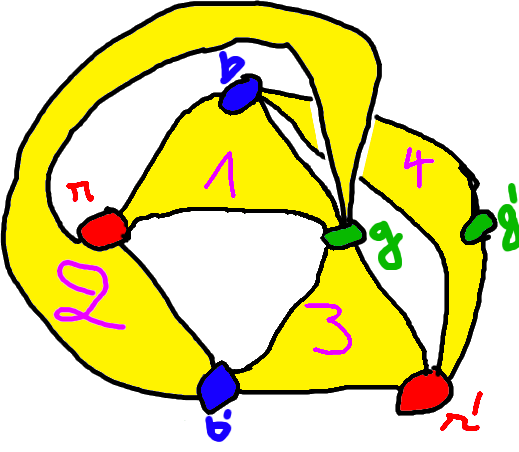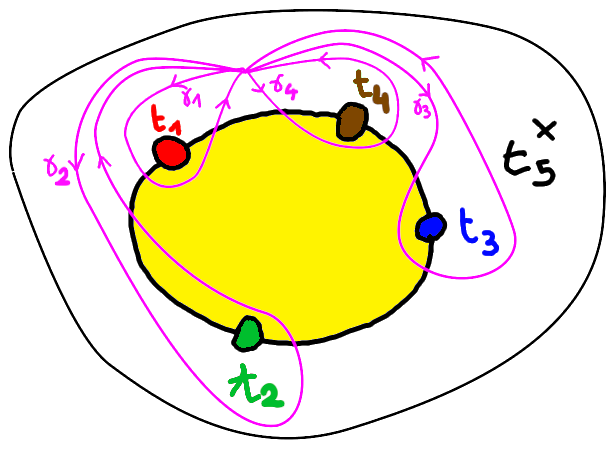Generalized dessins — Part 1: the definition
Grothendieck’s initial wonder for the action of
We fix an integer
Definition (cyclical order):
A cyclical order on a finite set
the category of dessins
Definition (
- For each color
- A finite set
- For each color
The case
We now give an example of a
Example:
We denote by
- The maps
- The cyclical order on hyperedges having
We now define morphisms between dessins:
Definition (morphism of dessins):
Let
-
for every color
-
for every vertex
When
These two notions define a category
Definition (degree of a dessin):
The degree of an
Definition (degree of a vertex):
The degree
Proposition:
Let
Definition (index of a color):
The index of the color
drawing a dessin
To draw a dessin, we adopt the following conventions:
- If
-
The interior of hyperedges is always colored yellow. If

If
- Let
These constraints define a notion of “good embeddings” of a dessin on a compact oriented surface.
If one moreover requires that the complement of the image of this embedding be a disjoint union of disks (to avoid “unnecessary genus”), these constraints rigidify the surface and the embedding if we identify two embeddings which are related by a direct homeomorphism between the surfaces.
In other words, dessins (which we have defined abstractly) also admit an equivalent (slightly more geometrical) definition as embeddings of
Because of these conventions, dessins can not always be drawn on paper (or, in this case, on your computer screen): because of this, we will have to draw some overlaps (an hyperedge passes “above” another), in which case we use the same conventions as when drawings e.g. knots or braids.
Example:
We draw the dessin

As you can see, there is an (unavoidable) overlap between hyperedges
monodromy
Definition (monodromy elements):
Let
The degree of a vertex
Definition (monodromy group):
Let
We also define the
Example:
The
The definition of morphisms of dessins directly implies:
Lemma:
Let
dessins and branched covers of the line
configurations and bouquets
Denote by
Definition (bouquet):
A bouquet of
- for each
- for each
- the trajectories of the loops
- the cyclical order in which one meets these loops when one rotates positively around the point
Under these conditions, the loops
dessins and covers
Fix a bouquet
Now, if
- the set
- the cyclical order on hyperedges (elements of
In other words, an
These two inverse constructions define an equivalence of categories between
Theorem:
The category
By Riemann’s existence theorem, the latter category is itself equivalent to the category of dominant and generically étale finite maps from a smooth curve to
The degree of the cover corresponding to a given dessin is the number of hyperedges of that dessin.
graphical interpretation
The relation between

Consider a finite cover of
an off-topic question
The following fact was told to me by Olivier Benoist:
Theorem:
A curve that has a finite morphism to
This is a generalization of the “easy part” of Belyĭ’s theorem.
For the proof, we denote by \overline{\Q(T)} for some reason)
Proof:
Using a homography, one can assume that the four branch points are
-
If
So our cover, and hence the curve, is defined over a number field.
-
If
Hence our cover comes from a cover of
More generally, the transcendance degree (over
Question: Is the theorem above an equivalence? i.e., can we generalize Belyĭ’s theorem to more general situations in this way?
My guess is that the answer is no.
In the next blog post, we will discuss the notions of connectedness and regularity of a dessin. Our ultimate goal is to describe “as combinatorially as possible” the action(s) of the absolute Galois group on these generalized dessins.